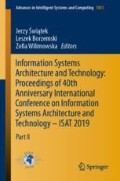Abstract
The redundancy concept has been developed of various approaches. However, these approaches concern only the positive association rules, the negative association rules are less studied, and this, with less selective pair, support-confidence. To do remedy these limits, we propose a new approach allowing to generate all non-redundant positive and negative rules, and this, using the new selective pair, support-\(M_{GK}\).
Access this chapter
Tax calculation will be finalised at checkout
Purchases are for personal use only
Notes
- 1.
For all \(X, Y\subseteq {\mathcal I}\), an association rule is negative if at least one two patterns is negative, of the form \(X\rightarrow \overline{Y}\), \(\overline{X}\rightarrow Y\) and \(\overline{X}\rightarrow \overline{Y}\), where \(\overline{{\mathcal A}}=\lnot {\mathcal A}={\mathcal I}\backslash {\mathcal A}\).
- 2.
For the sake of simplification, we will write P(X) instead of \(P(t(X)),~\forall X\subseteq {\mathcal I}\).
- 3.
- 4.
- 5.
References
Agrawal, R., Srikant, R.: Fast algorithms for mining association rules. In: Proceedings of 20th International Conference VLDB, pp. 487–499 (1994)
Bastide, Y., Taouil, R., Pasquier, N., Stumme, G., Lakhal, L.: Mining frequent patterns with counting inference. ACM-SIGKDD Explor. 2(2), 66–75 (2000)
Bemarisika, P.: Extraction de règles d’association selon le couple support-\(M_{GK}\): graphes implicatifs et application en didactique des mathématiques. Université d’Antananarivo (2016)
Bemarisika, P., Totohasina, A.: Erapn, an algorithm for extraction positive and negative association rules in Big Data. In: DaWaK, pp. 329–344. Springer (2018)
Bemarisika, P., Totohasina, A.: An efficient approach for extraction positive and negative association rules from Big Data. In: CD-MAKE, pp. 79–97. Springer (2018)
Feno, D.R., Diatta, J., Totohasina, A.: Galois lattices and based for \(M_{GK}\)-valid association rules. In: Proceedings of the 4th International Conference on CLA’06, pp. 127–138 (2006)
Feno, D.R.: Mesure de qualité des règles d’association: Normalisation et caractérisation des bases. Ph.D. thesis, Université de La Réunion (2007)
Ganter, B., Wille, R.: Formal Concept Analysis: Mathematical Foundations. Springer, Heidelberg (1999)
Guigues, J.L., Duquenne, V.: Familles minimales d’implications informatives résultant d’un tableau de donnés binaires. Maths. et Sciences Humaines, pp. 5–18 (1986)
Kryszkiewicz, M.: Concise representations of association rules. In: Hand, D.J., Adams, N.M., Bolton, R.J. (eds.) Pattern Detection and Discovery, pp. 92–103 (2002)
Latiri, C., Haddad, H., Hamrouni, T.: Towards an effective automatic query expansion process using an association rule mining approach. J. Intell. Inf. Syst. 39(1), 209–247 (2012)
Mannila, H., Toivonen, H.: Levelwise search and borders of theories in knowledge discovery. Data Min. Knowl. Disc. 1(3), 241–258 (1997)
Pasquier, N.: Frequent closed itemsets based condensed representations for association rules. CNRS (UMR6070), France, pp. 248–273 (2009)
Séverac, F., et al.: Non-redundant association rules between diseases and medications: an automated method for knowledge base construction. Med. Inform. Decis. Mak. 15(1), 29 (2015)
Zaki, M.J.: Mining non-redundant association rules. In: Proceedings of the Knowledge Discovery and Data Mining (2004)
Author information
Authors and Affiliations
Corresponding author
Editor information
Editors and Affiliations
Rights and permissions
Copyright information
© 2020 Springer Nature Switzerland AG
About this paper
Cite this paper
Parfait, B., André, T. (2020). Elimination of Redundant Association Rules. In: Świątek, J., Borzemski, L., Wilimowska, Z. (eds) Information Systems Architecture and Technology: Proceedings of 40th Anniversary International Conference on Information Systems Architecture and Technology – ISAT 2019. ISAT 2019. Advances in Intelligent Systems and Computing, vol 1051. Springer, Cham. https://doi.org/10.1007/978-3-030-30604-5_19
Download citation
DOI: https://doi.org/10.1007/978-3-030-30604-5_19
Published:
Publisher Name: Springer, Cham
Print ISBN: 978-3-030-30603-8
Online ISBN: 978-3-030-30604-5
eBook Packages: Intelligent Technologies and RoboticsIntelligent Technologies and Robotics (R0)

